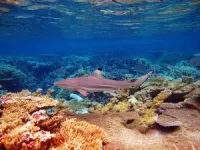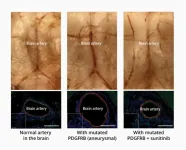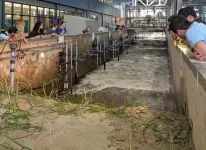(Press-News.org) Marine heatwaves are emerging as a key impact of climate change and pose a particularly significant threat to corals that form the backbone of coral reefs. Researchers have now identified a phenomenon that could help coral reef managers better plan and act for the future.[1]
Every few years, the cyclic climate pattern called El Niño arises in the tropical Pacific, causing significant changes in winds, weather and ocean temperatures. From April 2015 to May 2016, the Central Pacific witnessed one of the strongest El Niño events ever recorded.
Coral reefs were so stressed by the warmer ocean temperatures that they experienced mass bleaching, whereby the stress caused corals to expel their symbiotic algae and become white. Now, scientists at KAUST along with international colleagues have identified localized ocean processes during this El Niño that provided much-needed sustenance to the coral reefs on the Central Pacific island of Palmyra, allowing them not only to survive, but to thrive. Their findings improve understanding of how and why coral reefs respond differently to stress.
Crucially, improving the ability of managers and conservationists to identify naturally protected reefs could form the basis for repopulating corals that are more exposed to the impacts of climate change.
“We had no idea that something positive could come from El Niño,” says KAUST coral reef ecologist Michael Fox. “The same processes that caused coral reefs to die on Central Pacific islands on the equator led to positive conditions just a bit further north. The real surprise is that something beneficial for corals happened during such a major El Niño.”
Fox is referring to the interesting chain of events in 2015-16 that helped Palmyra’s reefs survive, while those a mere 700km south on the equatorial islands of Kiritimati and Jarvis did not.
During El Niño, the ocean current at the equator is weakened, reducing the beneficial nutrients that are typically brought to the surface when this current is flowing strongly.
But further north, Fox and his colleagues found that the eastward-flowing North Equatorial Counter Current, which hits Palmyra’s western shores, was significantly strengthened during the 2015-16 El Niño. This, together with the development of a shallower sea surface layer around Palmyra, drove an upward movement of cooler plankton-rich waters to the island’s coral reefs. This process enabled the reefs to better manage the heat stress brought on by the rise in ocean surface temperatures.
Fox and his colleagues found that ocean models demonstrated that the life-saving processes that occurred during the 2015-16 El Niño were also present during the other two major El Niños to occur in the past half century. The data suggests that these ocean processes helped Palmyra’s corals survive during the most extreme marine heatwaves they have faced in the past and may continue to do so in the future.
“El Niño-associated heatwaves are the greatest threat to coral reef ecosystems globally,” explains Fox. “These events have far-reaching impacts across the tropics and can result in mass coral mortality across vast areas. Identifying coral reefs that have a greater chance of survival during these extreme events is critical to understanding the future of coral reef ecosystems.”
The study’s findings beg the question: are there other places where such ocean conditions align during El Niño and where reefs are doing better than expected?
“Our study provides a roadmap for looking more broadly for reefs that are bucking the global trend of decline,” says Fox. “This information is going to be important for people in the Pacific islands that are trying to decide where to put marine protected areas or to plan for the future.”
Palmyra was especially suited to this research, as it is an uninhabited U.S. federally protected island that, since 2006, has been home to a small research station established by The Nature Conservancy. By studying such an isolated ecosystem, Fox and his colleagues were able to identify connections between ocean processes and coral survival that would be difficult to isolate on reefs impacted by humans.
“Palmyra Atoll is an ideal living laboratory to study the impacts of climate change on coral reefs and, importantly, to identify keys to reef resilience,” explains Joseph Pollock, senior coral reef resilience scientist of The Nature Conservancy’s Hawaii & Palmyra Programs.
“Its remoteness and highly protected status have helped the atoll’s reefs maintain their ecological integrity, while many reefs around the world have declined from local stressors, such as pollution or overfishing,” explains Pollock. “By comparing the responses of coral reefs in Palmyra to those in more degraded or disturbed areas, researchers can better isolate and understand the specific effects of climate change.”
Fox’s Ecological Oceanography Lab at KAUST plans to continue this research in Palmyra and to extend it to the Red Sea. The work is a collaboration between KAUST, Bangor University in the U.K., Scripps Institution of Oceanography and the National Oceanic and Atmospheric Administration in the U.S., and The Nature Conservancy.
“My group integrates organismal physiology, community ecology and oceanography to identify the patterns and processes that will help reefs survive climate change. We are exploring similar questions in the Red Sea and working to identify the physical processes that can help these unique reefs persist in such an extreme environment,” says Fox.
END
Ocean current comes to the rescue for Pacific island reefs
2023-06-14
ELSE PRESS RELEASES FROM THIS DATE:
'Smart' drugs can decrease productivity in people who don't have ADHD, study finds
2023-06-14
New research from the University of Cambridge and the University of Melbourne, published in Science Advances, shows neurotypical workers and students taking cognitive enhancers, or ‘smart’ drugs, may actually be inhibiting their performance and productivity.
Drugs such as methylphenidate, sold under the brand name Ritalin among others, are commonly prescribed for attention deficit hyperactivity disorder (ADHD), but are also taken by those without a diagnosis, in the belief that the drugs will enhance focus and cognitive performance.
In four double-blinded, ...
The mutant origin of brain aneurysms and the first drug treatment
2023-06-14
Researchers at the RIKEN Center for Brain Science (CBS) in Japan have discovered a set of related mutations that lead to intracranial aneurysms—weakened blood vessels in the brain that can burst at any time. The mutations all appear to act on the same biological signaling pathway, and the researchers report the first ever pharmaceutical treatment in a mouse model, which works by blocking this signal. The study was published in Science Translational Medicine on June 14.
About 5% of the population have unruptured intracranial aneurysms in blood vessels on the surface of the brain. Despite being ballooned arteries with ...
Massive hemorrhages are often deadly. Can a perfume ingredient stop the bleed and save lives?
2023-06-14
The chances of surviving massive blood loss from a traumatic injury such as a gunshot wound are around 50 percent. To survive, a patient needs two things to happen quickly: a large infusion of blood and coagulation at the wound to stop the bleeding.
The problem is one of these solutions prevents the other. Introducing a large amount of blood to those suffering a massive hemorrhage impairs the blood’s ability to clot, a condition known as coagulopathy.
Now, Tulane University researchers have uncovered the cause of coagulopathy in trauma victims receiving a blood infusion. They also found that a synthetic compound ...
Altered gut bacteria may be early sign of Alzheimer’s disease
2023-06-14
People in the earliest stage of Alzheimer’s disease — after brain changes have begun but before cognitive symptoms become apparent — harbor an assortment of bacteria in their intestines that differs from the gut bacteria of healthy people, according to a study by researchers at Washington University School of Medicine in St. Louis.
The findings, published June 14 in Science Translational Medicine, open up the possibility of analyzing the gut bacterial community to identify people at higher risk of developing dementia, and of designing microbiome-altering preventive treatments to stave off cognitive decline.
“We don’t yet know ...
Elimination of type of bacteria suggests treatment for endometriosis
2023-06-14
A research group from the Graduate School of Medicine and iGCORE at Nagoya University in Japan, has discovered that using an antibiotic to target Fusobacterium reduced the formation of lesions associated with endometriosis, a gynecological disorder characterized by endometrial tissue usually found inside the uterus being found outside it. Their findings suggest an alternative treatment for this disorder. The study was published in Science Translational Medicine.
Endometriosis affects one in ten women between the ages of 15 and 49. The disorder can cause lifelong health problems, including pelvic pain and infertility. ...
Newly planted vegetation accelerates dune erosion during extreme storms, research shows
2023-06-14
CORVALLIS, Ore. – Newly planted vegetation on coastal sand dunes can accelerate erosion from extreme waves, a study involving researchers from the Oregon State University College of Engineering suggests.
The authors note the findings run counter to the widely accepted paradigm that vegetation always acts to reduce erosion on dunes, the first line of storm defense for landscapes that are among the world’s most ecologically important and economically valuable.
The experiments involved building beach dune profiles 70 meters long and 4.5 meters high and subjecting ...
Preserving forests to protect deep soil from warming
2023-06-14
A recent study led by scientists at Lawrence Berkeley National Laboratory (Berkeley Lab) and the University of Zurich has revealed that the organic compounds proposed for carbon sequestration in deep soil are highly vulnerable to decomposition under global warming.
The finding has implications for a key strategy in carbon management that relies on soil and forests – natural carbon “sinks” – to mitigate global warming.
About 25 percent of global carbon emissions are captured by forests, grasslands, and rangelands. During photosynthesis, plants store carbon in their cell walls and in the soil. Because ...
Treatment creates steel alloys with superior strength and plasticity
2023-06-14
WEST LAFAYETTE, Ind. — A new treatment tested on a high-quality steel alloy produces extraordinary strength and plasticity, two traits that must typically be balanced rather than combined. Ultra-fine metal grains that the treatment produced in the outermost layer of steel appear to stretch, rotate and then elongate under strain, conferring super-plasticity in a way that Purdue University researchers cannot fully explain.
The researchers treated T-91, a modified steel alloy that is used in nuclear and petrochemical ...
TCT 2023 Program Guide now available
2023-06-14
NEW YORK – June 14, 2023 – The Cardiovascular Research Foundation (CRF) has announced the TCT 2023 Program Guide is now available. TCT is the annual scientific symposium of CRF and the world’s premier educational meeting specializing in interventional cardiovascular medicine. TCT 2023 will take place October 23-26 in San Francisco, California, at the Moscone Center and will celebrate 35 years of leading the field.
Every year, TCT features major medical research breakthroughs and gathers ...
Plate tectonics not required for the emergence of life
2023-06-14
Scientists have taken a journey back in time to unlock the mysteries of Earth’s early history, using tiny mineral crystals called zircons to study plate tectonics billions of years ago. The research sheds light on the conditions that existed in early Earth, revealing a complex interplay between Earth’s crust, core, and the emergence of life.
Plate tectonics allows heat from Earth’s interior to escape to the surface, forming continents and other geological features necessary for life to emerge. Accordingly, “there has been the assumption that plate tectonics is necessary for life,” says John Tarduno, who teaches in the Department ...







